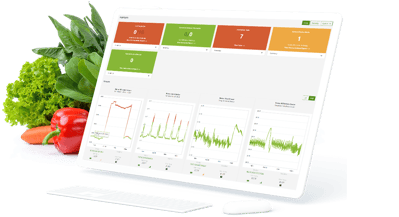
The World Health Organization estimates that foodborne illness occurs in 600 million people, and is fatal to 420,000 people worldwide each day.1 These statistics alone make the ability to take measures to prevent, detect, and mitigate food safety risks a top priority throughout the supply chain. Both IoT and big data are proving their effectiveness in ensuring food safety.
What Are IoT and Big Data?
Big data refers to the rapid gathering of large amounts of data from multiple devices. The incredible amounts of information gathering big data allows for is far too much for any human to process quickly or efficiently.
The internet of things (IoT) is the collector of big data from those devices. IoT and big data work together to collect and process data, making it easier to consume, process, and analyze.
How the Internet of Things Is Improving Food Safety
The internet of things sees the integration of data from several sources. In terms of food safety, those sources exist in the form of temperature, ph and humidity sensors. Whether installed on food trucks, smokers, refrigerators and freezers, or in other areas where food is stored or prepared, these sensors record data that is constantly being sent to an IoT platform.
Collected data in the IoT platform can be extracted in any desired combination, and then examined. What does this mean for food safety? Simply put, IoT provides managers and owners with a 360 degree view of their environment. In just a few clicks, important information about the conditions and food temperatures in refrigerators, smokers, labs, greenhouses and more can be viewed and interpreted from any web enabled device.
IoT’s ability to allow access, viewing, and analyzing of data means that risks to food safety can be identified and addressed before food products have the chance to reach the customer.
Big Data and Food Safety
The big data gathered from temperature sensors, databases, and handheld devices used to complete digital checklists can help owners and managers make informed and timely decisions related to food safety. For example, the information contained in big data can help to prevent inventory loss with pre-empted equipment failure when trends are noted through the data.
Those who view historical temperature data can identify when freezers and refrigerators are not keeping food at safe temperatures and move food to operational appliances before it becomes unusable.
Big data also ensures food safety by timestamping the real-time data it collects. Timestamping helps to make it easier to prove compliance during food safety audits, as well as reduce the number of food safety claims made by consumers.
The timestamped information found in recorded data also assists auditors, owners, managers, and others in conducting root cause analysis far more efficiently than with manual methods.
Food Safety Technology for Every Foodservice Business

Food delivery, restaurant, hospitality, retail, and other foodservice businesses have always found it challenging to achieve loss prevention and food safety. Thanks to IoT and big data, this is no longer the case.
ComplianceMate combines the power and efficiency of IoT and big data and allows foodservice businesses to achieve food safety compliance, operational efficiency, higher ROI, and much more.
Our system uses high-quality IoT sensors that issue immediate alerts when temperatures fluctuate out of range. The ComplianceMate suite of industry-specific tools also includes wireless Bluetooth temperature probes, which offer complete portability, capture and transmit large amounts of data, and allow employees to complete temperature checks in seconds.
The sensor- digital safety and workflow checklists eliminate the need for manual recordings and the human error which accompanies them. The interface is easy to use, and also informs employees with prompts and corrective actions for accuracy and consistency.
Finally, the customizable dashboard stores all big data collected by sensors, probes, and checklists and allows this information to be viewed and analyzed remotely from any device for complete control of your operations.
Schedule your no-obligation, personalized demonstration of our scalable solution online today!
Source:

